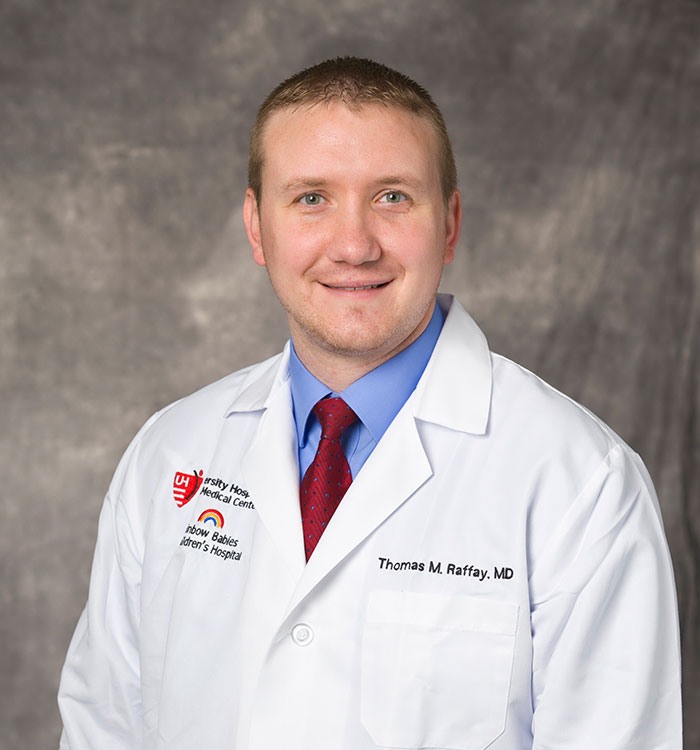UH Neonatologist Wins NIH Funding to Develop Therapy for Bronchopulmonary Dysplasia
July 02, 2024

Innovations in Pediatrics | Summer 2024
Oxygen therapy is life-saving for premature infants treated in the neonatal intensive care unit (NICU). However, it often has the consequence of leading to bronchopulmonary dysplasia (BPD), damaging the infant’s fragile airways and creating tissue destruction in the tiny alveoli. The results can be devastating. In the U.S. alone, more than 10,000 new diagnoses of BPD are made annually with estimated costs exceeding $2.5 billion.
 Thomas Raffay, MD
Thomas Raffay, MDThe human toll is also great.
“We have babies that pass away with BPD in the NICU who simply outgrow their lungs and can never recover, or they have complications like pulmonary hypertension that develops over time,” says Thomas Raffay, MD, a neonatologist at UH Rainbow Babies & Children’s Hospital. “Unfortunately, in 30 years not much has changed in terms of treatment.”
Patients treated with oxygen therapy in the NICU as “micro-preemies” at 22 or 23 weeks are also now presenting years later with persistent lung disease in their teens and 20s – a consequence of BPD.
But now, Dr. Raffay is pursuing a new promising avenue for treatment of BPD, supported by a prestigious R01 $2.3 million grant from the National Institutes of Health. He is building on years of painstaking pre-clinical research, which revealed that neonatal hyperoxia, a condition found in the NICU, causes the beneficial enzyme GSNO to be catabolized in the lungs by the enzyme GSNO reductase (GSNOR).
In experiments with GSNOR “knockout mice,” for example, Dr. Raffay found that “editing out” that enzyme reduced the alveolar simplification, airway hyper-reactivity and pulmonary hypertension associated with BPD. What’s more, he found that oxygen-induced airway hyper-reactivity can be reversed with inhaled GSNO or a GSNOR inhibitor, now currently available in Phase 1 clinical trials for asthma and cystic fibrosis.
In fact, UH Rainbow Babies & Children’s Hospital was part of the GSNOR inhibitor trial for cystic fibrosis and is currently studying inhaled GSNO with James Reynolds, PhD, Professor of Anesthesiology & Perioperative Medicine at Case Western Reserve University and a Harrington Scholar with the Harrington Discovery Institute at University Hospitals.
With the new NIH grant, Dr. Raffay and his research team will delve more deeply into molecular, mechanisms, studying how protection occurs from neonatal hyperoxia in GSNOR genetic knockout mice, with an eye toward better understanding the roles of GSNOR in the lung epithelia and myeloid cells. Importantly, they will also test pharmacologic GSNO and GSNOR-based therapies.
Which is likely to work best?
“I think that the inhibitor will probably be as effective as the “knockout mice” because it is systemically doing everything, whereas the GSNO is probably effecting mostly the airways through aerosolizations,” Dr. Raffay says. “It's also broken down so quickly. I think the inhibitors are where the action is going to be, so to speak, but focusing delivery to just the lungs might be preferable, so I'm going to test both.”
To validate his work, Dr. Raffay is also collecting cell samples from the breathing tubes of intubated infants in the NICU over the first four weeks of life, looking to see whether the molecular changes he’s noted in experimental animals are also present in premature infants.
“We have early indicators that’s what happening in mice is also happening in babies that get BPD,” he says. “We're looking for the enzymes that breaks down that good GSNO, and we're seeing that many are elevated. Actually, we’re finding that airway GSNOR is elevated in proportion to the severity of their lung disease. This suggests that if this intervention, this therapy, works in mice, there’s more momentum that maybe it might be helpful in babies to protect their small lungs from oxygen injury.”
For more information about Dr. Raffay’s research, please email Peds.Innovations@UHhospitals.org.
Contributing Expert:
Thomas Raffay, MD
Neonatologist
UH Rainbow Babies & Children’s Hospital
Instructor of Pediatrics
Case Western Reserve University School of Medicine


